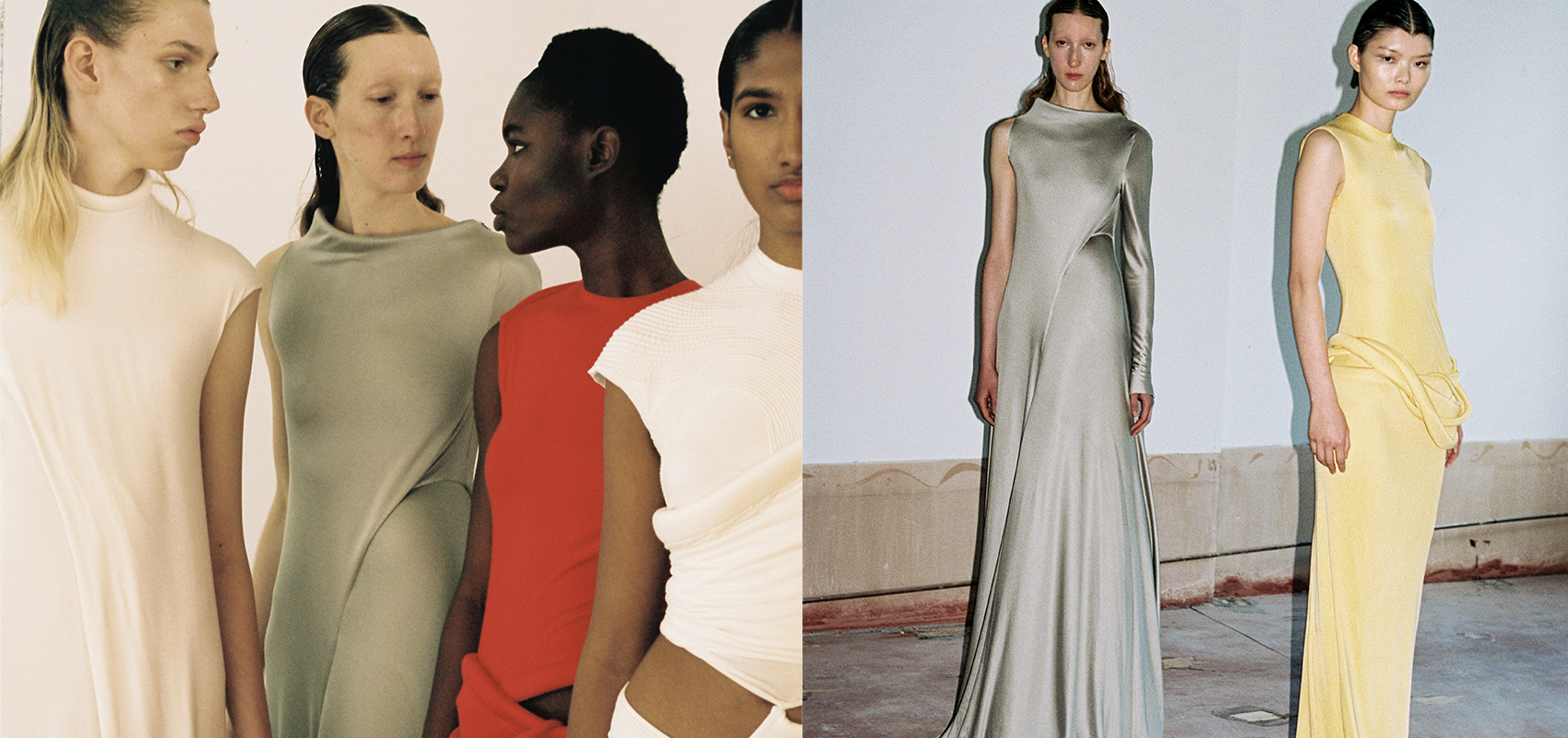Designer Michael Stewart makes a case for quiet competence over theatrical viral moments in the latest installment of our Sarabande series.
Who Michael Stewart’s design inspirations are is a mundane question for him. He has studied the work of the greats like Charles James, Madeleine Vionnet, and Cristobal Balenciaga, since it’s important to understand garment construction, but: “I’m not a designer who has mood boards with references of other designers’ work on.” The founder of Standing Ground and Sarabande resident artist actively tries not to look at other peoples’ work. “I’m not saying I’m doing anything totally radical,” he clarifies, “But I’m just trying to have my own lane.”
Rather than image boards and sketches, the Irish designer drapes everything. “That’s the starting point, and then the pattern is made from that. The process of making and designing is entwined in that way because it allows you to discover things that you wouldn’t necessarily do on paper,” Stewart explains. Sometimes designers fall into the trap of having great sketches and concepts which don’t shine through in the execution. This way, “[you] feel what the material wants to do.” He believes that “there’s too much focus put on concept.” Fashion schools must emphasize all aspects of the process, not least because gaps in a designer’s skill will limit their aesthetic.
With fashion spectacle having become so loud in recent years, Standing Ground’s appeal comes from clean design and skilled cutting. His statuesque dresses may seem deceptively simple, but executing them takes skill. The designer places construction elements like seam lines very intentionally, and actually makes them a feature of the garment: “They must flow with the body and work with the figure. I think that’s as much an important design element as anything else.” This “complex simplicity” creates a pure, modern look, fused with Stewart’s ancient inspiration of Ireland’s standing stones.
“The thing is, I’m 34 now. Sometimes I get described as a young designer, and I’m like, I’m not a young designer because it’s taken me so long to get here. ”
Between graduating from London’s Royal College of Art in 2017 and founding Standing Ground in 2021, Stewart worked almost constantly on his brand, developing and designing in his own time, and working jobs that would fund his endeavors. Many will give up in that time frame, he notes: “I could have easily jacked this in a couple years ago.” Then, when he was picked up by Fashion East to present at their Spring/Summer 2023 show, it opened doors for the designer. So much has happened in less than a year since his first show in September, including a custom Standing Ground dress worn by model Imaan Hammam at the Met Gala. “People really take you seriously once you work with [Fashion East],” the designer noted.
Stewart had been doing everything at home until he moved into the Sarabande studios this year, which are heavily subsidized to support emerging artists. This really puts into perspective how vital talent incubators like Fashion East and Sarabande are for upcoming designers in London. He’s incredibly grateful for this support, he tells me. “These platforms are really, really important because without them it’s kind of impossible.” Both having a show at London Fashion Week and paying for a studio space in London are very costly.
“The thing is, I’m 34 now. Sometimes I get described as a young designer, and I’m like, I’m not a young designer because it’s taken me so long to get here,” he observes drily. Stewart thinks there should be a shift in fashion away from always thinking that younger is better. “I’ve always respected people’s skill,” he says. Skill comes with time, so the fixation on youth can sometimes be antithetical to that.
Having spoken about the tireless work it’s taken to get here, the conversation moves to the present. How does the designer feel now, at this stage in his career, where he’s starting to get noticed? “Cautious,” he says. “You get a lot of opportunities coming up, but I have to be very protective because people are always interested in the new person or the new work that’s happening.”
“I mean, how many people have you seen just disappear over the years in London?” he says, noting that it’s like a “carousel.” Stewart wants to grow sustainably and is wary of following the wholesale business model, which he thinks is dangerous for new designers. “Even some of the medium-sized brands that have been around for a long time, they’re just surviving.” He’s been approached by stockists, but he wants to take his time and go down a more artisanal route, making to measure for clients.
“You get a lot of opportunities coming up, but I have to be very protective because people are always interested in the new person or the new work that’s happening.”
“I think it’s important to develop things properly. There’s always that idea that you have to strike while the iron is hot and whilst you’re a graduate from a good school,” Stewart notes of the pressure on emerging designers. “But, I just think if you consistently do good work, you cannot be ignored forever. And that was what I said to myself over the past couple of years.”
All imagery courtesy of Standing Ground.





